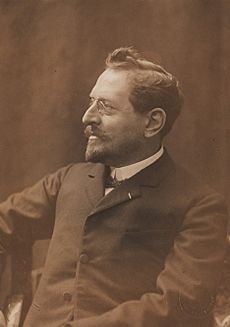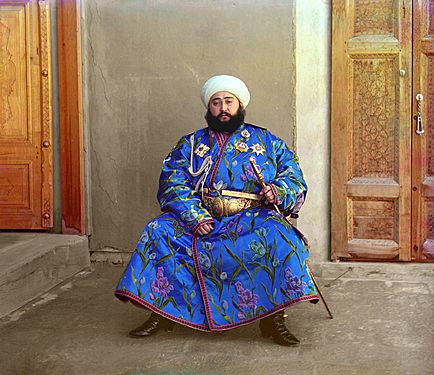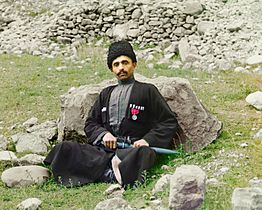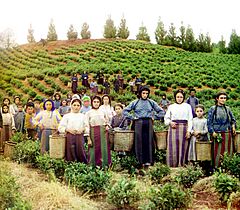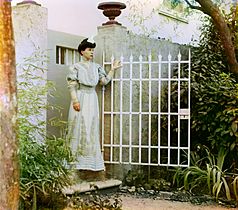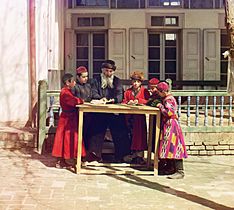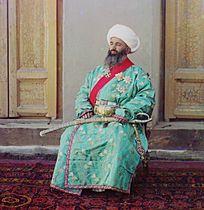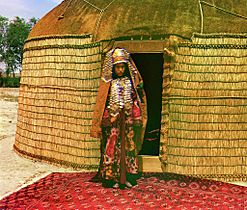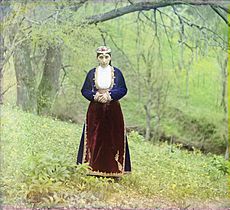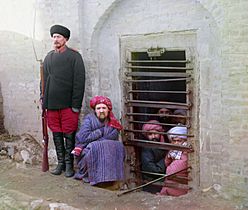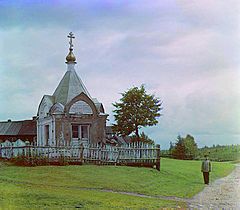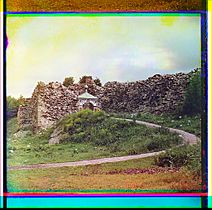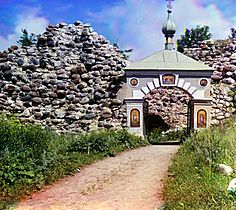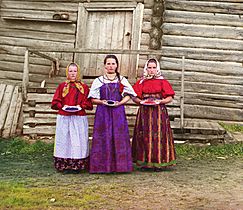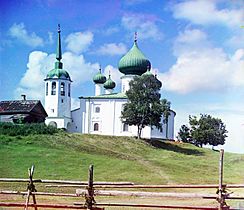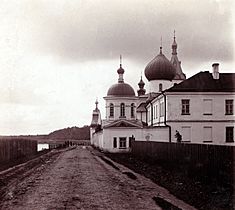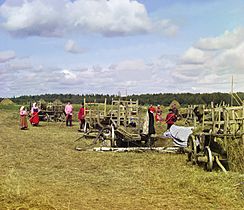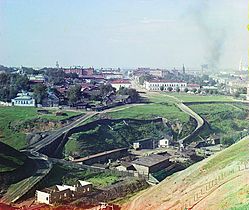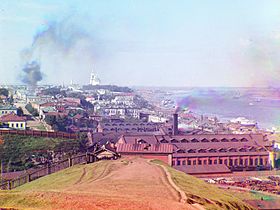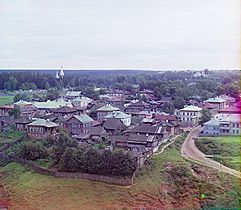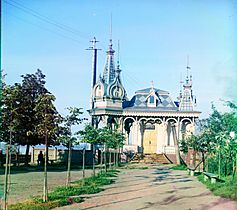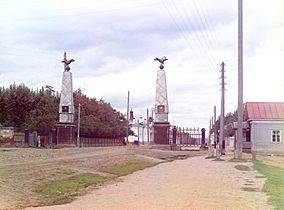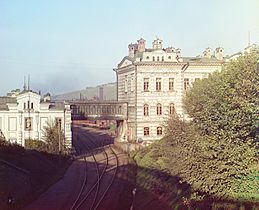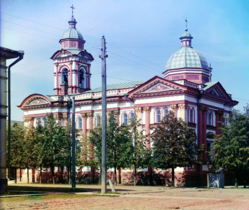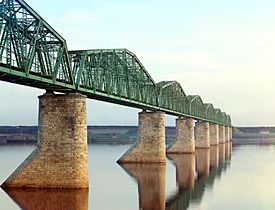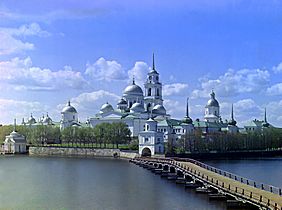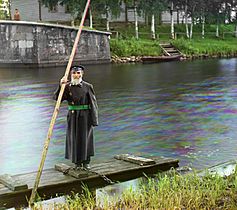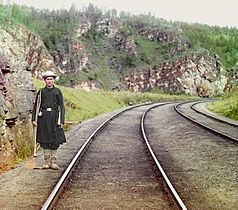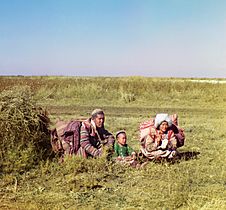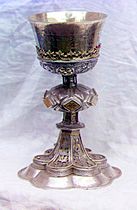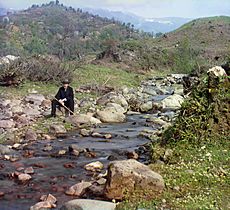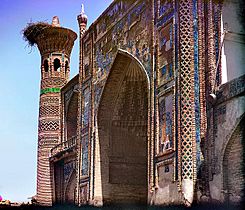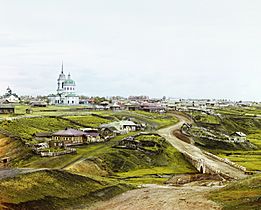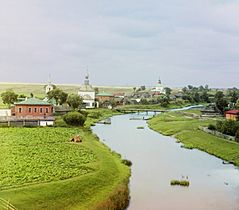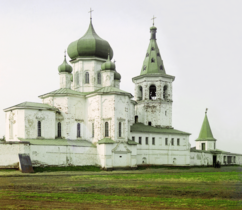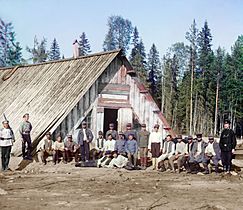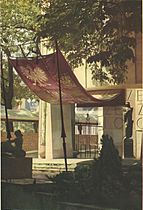Sergey Prokudin-Gorsky facts for kids
Quick facts for kids
Sergey Prokudin-Gorsky
|
|
|---|---|
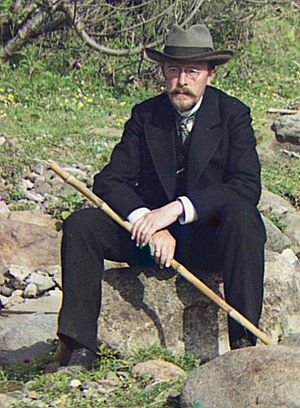
Prokudin-Gorsky in 1912
|
|
| Born | August 30 [O.S. August 18] 1863 Murom, Vladimir Governorate, Russian Empire
|
| Died | September 27, 1944 (aged 81) Paris, France
|
| Resting place | Sainte-Geneviève-des-Bois Russian Cemetery |
| Nationality | Russian |
| Known for | Early techniques for taking colour photographs |
Sergey Mikhaylovich Prokudin-Gorsky (born August 30, 1863 – died September 27, 1944) was a Russian chemist and photographer. He is famous for his early work in color photography. He also worked hard to photograph Russia in the early 1900s.
Sergey Prokudin-Gorsky traveled across the Russian Empire from about 1909 to 1915. He used a special train car that worked as a darkroom. This car was given to him by Tsar Nicholas II. He took many color photos using a special three-image method.
After he died, most of his photo negatives ended up in the US Library of Congress. Starting in 2000, these negatives were made digital. The three color images for each photo were put together. This created hundreds of high-quality color pictures of Russia from over 100 years ago.
Contents
About Sergey Prokudin-Gorsky
His Early Life and Studies
Sergey Prokudin-Gorsky was born in Murom, a town in Russia. His family was part of the Russian nobility, meaning they were from important families. They had a long history of serving in the military. Later, his family moved to Saint Petersburg. There, Sergey studied chemistry at the Saint Petersburg State Institute of Technology. He learned from a famous chemist named Dmitri Mendeleev. He also studied music and painting at the Imperial Academy of Arts.
Marriage and Photography Career
In 1890, Prokudin-Gorsky married Anna Aleksandrovna Lavrova. They had two sons, Mikhail and Dmitri, and a daughter, Ekaterina. Anna's father was a well-known Russian businessman. Prokudin-Gorsky later became a director at his father-in-law's metal factory. He worked there until the October Revolution.
He also joined Russia's oldest photography group, part of the Imperial Russian Technical Society (IRTS). He gave talks and lectures about the science of photography.
In 1901, Prokudin-Gorsky opened his own photo studio and lab in Saint Petersburg. The next year, he went to Berlin, Germany. For six weeks, he studied color photography with Adolf Miethe. Miethe was a leading expert in photochemistry at that time.
Over the years, Prokudin-Gorsky's photos, writings, and slide shows became very popular. He showed his work to scientists and photographers in Russia, Germany, and France. In 1906, he became the president of the IRTS photography section. He also became the editor of Russia's main photography magazine, Fotograf-Liubitel.
One of Prokudin-Gorsky's most famous photos was a color portrait of the writer Leo Tolstoy. This picture was printed in many magazines and on postcards. Its fame, along with his other photos of Russia's nature and old buildings, led to special invitations. In 1908, he showed his work to the Grand Duke Michael Alexandrovich and the Dowager Empress Maria Feodorovna. In 1909, he showed them to Tsar Nicholas II and his family.
The Tsar liked the photos very much. With the Tsar's support, Prokudin-Gorsky received permission and money to photograph Russia in color. His goal was to take 10,000 photos over ten years. He saw this as his life's work. He continued his photo trips across Russia even after the October Revolution.
Under the new government, he was asked to become a professor. In 1918, he was sent to Norway to get projection equipment. He kept working on color photography and got patents in several countries.
Later Life and Passing
In 1920, Prokudin-Gorsky married again and had another daughter. In 1922, his family finally settled in Paris, France. There, he reunited with his first wife and children. Prokudin-Gorsky opened a photo studio with his three older children.
In the 1930s, Prokudin-Gorsky was older but still gave talks. He showed his photos of Russia to young Russians living in France. He stopped doing commercial work and left the studio to his children. He passed away in Paris on September 27, 1944. He is buried in the Sainte-Geneviève-des-Bois Russian Cemetery.
How He Took Color Photos
The Three-Color Method
Sergey Prokudin-Gorsky used a special way to take color photos. This method was first thought of by James Clerk Maxwell in 1855. It works like how our eyes see color. The camera takes three separate black-and-white photos of the same scene. Each photo is taken through a different colored filter: one red, one green, and one blue.
Later, these three black-and-white photos could be shown through filters of the same colors. When projected onto a screen and perfectly lined up, they would create a full-color image. People could also look at them through a special device called a chromoscope. This device used colored filters and mirrors to combine the three images into one color picture.
Special Cameras and Movement
Early color photographers often used special cameras. These cameras made it easier and faster to take the three photos. Some cameras used mirrors to take all three pictures at the same time. This was good because nothing in the scene would move between shots.
Other cameras, like the one Prokudin-Gorsky likely used, took the pictures one after another. They had a special sliding holder for the glass plates and filters. This allowed each filter to be moved into place quickly.
When photos were not taken at the same time, any moving objects in the scene could cause colored "fringes" or "ghost" images. For example, if a person moved their arm, it might appear with colored edges. Modern computer programs can now fix these issues. They make the old photos look much clearer and more natural.
Prokudin-Gorsky was also an inventor. He patented an optical system for cameras. However, it is believed he used a camera designed by Adolf Miethe, his teacher. This camera took images in a blue-green-red order on a single glass plate.
Documenting the Russian Empire
Around 1905, Prokudin-Gorsky had a big idea. He wanted to use new color photography technology to photograph the entire Russian Empire. His main goal was to teach Russian schoolchildren about their country. He wanted to show them the diverse history, culture, and changes happening in the empire. He planned to do this using his "optical color projections."
Tsar Nicholas II supported his project. Prokudin-Gorsky received a special railroad car that worked as a darkroom. He also got two permits that allowed him to go into restricted areas. This meant he could travel and photograph almost anywhere in Russia.
He documented the Russian Empire between about 1909 and 1915. He gave many lectures with his photos. His pictures show a clear view of Russia just before World War I and the Russian Civil War. He photographed many different things. These included old churches and monasteries, new railroads and factories, and the daily lives of people across Russia.
Prokudin-Gorsky believed he had about 3,500 negatives when he left Russia. However, about half of his photos were taken by Russian officials. They thought these photos contained information that was important for the war. The photos that were left behind were not of interest to the public. No other negatives from his collection have been found outside the ones at the Library of Congress.
By the time Prokudin-Gorsky died, the Tsar and his family had been killed. Most of the old empire had become the Soviet Union. The remaining boxes of his photo albums and fragile glass plates were stored in a basement in Paris. In 1948, the Library of Congress in the United States bought these materials from Prokudin-Gorsky's family. The library received 1,902 negatives and 710 album prints.
Bringing Old Photos to Life with Digital Color
-
This shows a simple color image of Alim Khan, Emir of Bukhara, from 1911. On the right, you can see the original three black-and-white images on glass. Prokudin-Gorsky took the top, middle, and bottom images through blue, green, and red filters.
For many years, it was very hard to make color prints from Prokudin-Gorsky's negatives. Only about a hundred of his images were shown in exhibits or books for 50 years after the Library of Congress got them.
Things changed with digital image processing. This technology made it easy to combine multiple images quickly. In 2000, the Library of Congress started a project to scan all of Prokudin-Gorsky's photos. They hired a photographer named Walter Frankhauser to combine the black-and-white negatives into color images. He made 122 color pictures. He said each image took him about six to seven hours to line up, clean, and fix the colors.
In 2001, the Library of Congress held an exhibition called The Empire That Was Russia: The Prokudin-Gorskii Photographic Record Recreated. Since then, his photos have been shown in many other exhibitions.
In 2004, the Library of Congress hired computer scientist Blaise Agüera y Arcas. He used computer programs to automatically create color versions of all 1,902 negatives. He used special math to fix differences between the exposures. The library now offers high-resolution images of the negatives for free online. This means many people can create their own color versions of the photos. His photos have become a popular way for computer scientists to test new ideas.
Gallery
Here are some of Sergey Prokudin-Gorsky's photographs. They have been digitally processed and are available from the Library of Congress:
-
Dagestani Sunni Muslim man, 1904
-
Jewish children with their teacher in Samarkand, circa 1905–1915
-
Woman in traditional dress standing on a rug in front of a yurt, circa 1905-1915
-
Armenian woman in national costume near Artvin, circa 1905–1915
-
The Kama River near Perm, 1910. The bridge still stands today.
-
Pinchas Karlinskiy, Supervisor of a floodgate at Chernigov, 1910
-
Chalice in the vestry of the Ipatevskii Monastery in Kostroma, 1911
-
A Madrasa in Samarkand, circa 1912
-
The Village of Kolchedan in the Ural Mountains, 1912
-
Austro-Hungarian POWs in Russia during World War I, 1915
See also
 In Spanish: Serguéi Prokudin-Gorski para niños
In Spanish: Serguéi Prokudin-Gorski para niños
- Levi Hill
- Thomas Sutton (photographer)
- Albert Kahn, who paid photographers to travel the world and record images and films of different cultures between 1909 and 1931.
- Ansel Adams, an American black-and-white photographer who took pictures of the American West.


